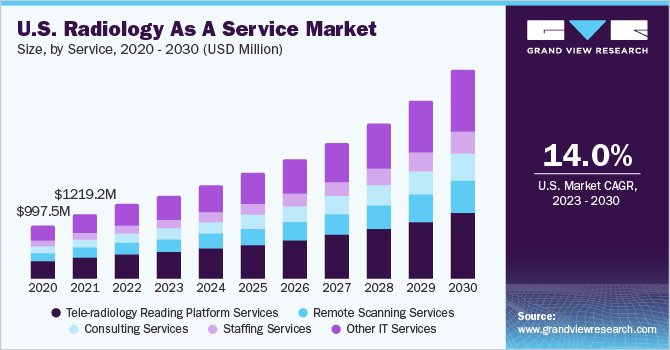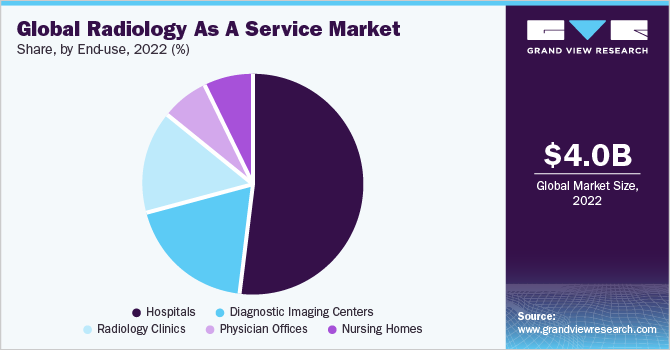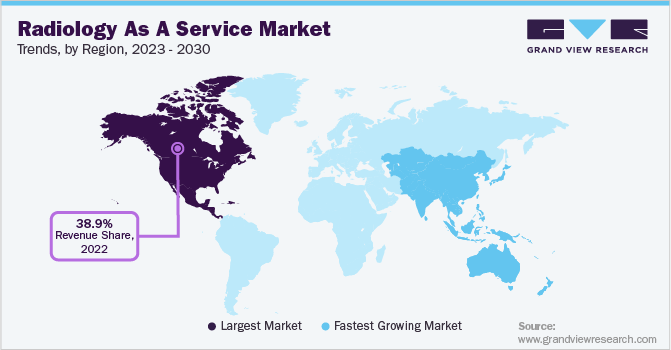- Home
- »
- Healthcare IT
- »
-
Radiology As A Service Market Size Analysis Report, 2030GVR Report cover
![Radiology As A Service Market Size, Share & Trends Report]()
Radiology As A Service Market Size, Share & Trends Analysis Report By Location (In-house, Off-shore, In-shore), By Service, By Modality, By End-use, By Region, And Segment Forecasts, 2023 - 2030
- Report ID: GVR-4-68039-671-1
- Number of Pages: 160
- Format: Electronic (PDF)
- Historical Range: 2017 - 2021
- Industry: Healthcare
Report Overview
The global radiology as a service market was valued at USD 4.0 billion in 2022 and is projected to expand at a compound annual growth rate (CAGR) of 14.7% from 2023 to 2030. Increasing demand for low-cost, advanced, cloud-based medical imaging services is the key driving factor for market growth. In addition, the rise in the number of medical images coupled with a shortage of skilled radiologists globally is contributing to market growth. Furthermore, access to advanced technologies with limited investment, and the scarcity of radiologists are expected to increase the demand. According to the Association of American Medical Colleges (AAMC), there will be a shortage of 17,100 to 41,900 radiologists in the U.S. In addition, as per the Royal College of Radiologists in April 2021, there was a shortfall of 33% of NHS radiologists in the U.K., which is estimated to increase to nearly 44% by 2025. This scarcity is expected to probably last for another 5 to 10 years, leaving many hospitals with a substantial deficit.

Moreover, the growing prevalence of target diseases, such as cancer, cardiovascular diseases, pneumonia, and Chronic Obstructive Pulmonary Disease (COPD), is driving the demand for radiology as a service. As per the American Cancer Society, in 2022, approximately 1.9 million new cancer cases were diagnosed in the U.S. Breast cancer is the most common cancer in women in the U.S. According to the American Cancer Society, approximately 287,850 new invasive breast cancer cases are predicted in the U.S. in 2022. Similarly, according to the WHO, COPD caused 3.23 million deaths in 2019 and is the third-leading cause of death globally. Furthermore, aging is considered as the greatest risk factor for developing degenerative disorders of joints, such as osteoporosis. Osteoarthritis and osteoporosis are some of the most common disorders in people aged over 70. As per CDC, around 58.5 million people suffer from arthritis in the U.S.
The radiology as a service concept allows healthcare providers to access advanced technologies in medical imaging with little investment. Medical imaging service models are being used by healthcare providers as a result of the growing demand for improved diagnostics at reasonable prices without compromising their long-term viability. If the healthcare provider has implemented as a service model in place, they are not required to buy expensive imaging equipment. They can also work with suppliers who offer the necessary tools and associated services in exchange for regular or pay-per-use payments. The upfront capital is significantly decreased as a result of this arrangement, which lessens the load on the care provider’s capital budget. Moreover, for cash-strapped hospitals with thin balance sheets, this approach is beneficial.
The COVID-19 pandemic negatively impacted the healthcare industry in the early phases of 2020 due to the drastic reduction in medical imaging procedures, which adversely affected the market for radiology as a service. Radiology department medical personnel were redirected to treating COVID-19 patients, which further reduced the volume of imaging procedures. The decrease in radiological imaging hospital visits was also brought on by patient concerns over virus transmission. As many radiologists began working from home during the pandemic, the workflow was significantly disrupted. However, the pandemic also raised the demand for online medical services further benefiting the teleradiology market. Besides, Telehealth gained momentum when Medicare lifted access limitations, allowing radiology to reach a wider audience. The practices during the pandemic increased the need for internal teleradiology and decreased the dependency on external teleradiology in the U.S.
Service Insights
Based on service, teleradiology reading platform services held the largest share of 33.6% in 2022. The growth of the segment can be attributed to the growing demand for medical imaging owing to the rising prevalence of chronic diseases such as cancer, cardiovascular diseases, and brain injuries. Remote imaging solutions are teleradiology reading platform services that help radiologists perform remote reading and provide high-quality patient care.
However, the other IT services segment is expected to witness the fastest growth during the forecast period. This can be attributed to increasing demand for various solutions for patient scheduling, revenue management, staffing services, and billing services to optimize workflow, improve efficacy, & decrease the number of denials of claims. Other IT services include patient booking & scheduling, documentation, and billing services. Service providers in the market offer various solutions that aid in scheduling patient appointments and enabling hassle-free documentation & billing process.
Location Insights
The inshore segment dominated the industry with a revenue share of 40.0% in 2022. The growth is attributed to the uneven distribution of radiologists and an increasing number of physicians/referrers not willing to make a diagnosis without confirmation through diagnostic radiology. Moreover, owing to the late working hours in radiology departments and increased demand for reporting imaging cases in the emergency department with a turnaround time of fewer than 4 hours have increased the need for onshore teleradiology services.
The offshore segment is expected to grow at the fastest CAGR over the forecast period. Factors such as the shortage of radiologists in various countries, the availability of radiologists during the night shift, and the high demand for low reporting costs are propelling segment growth. Moreover, the growing number of foreign-trained and certified radiologists in developing countries such as India and Australia is further propelling segment growth. In addition, due to the teleradiology facility, radiologists do not need to travel to access the images as they can be transferred anywhere. It eliminates the overhead cost of printing the images or the report. Thus, these factors are anticipated to propel segment growth.
Modality Insights
In 2022, the X-ray segment held the largest revenue share of 28.87% owing to the growing burden of chronic diseases along with rising awareness about early disease diagnosis. Continuous technological advancements such as improvements in the quality of images, image acquisition time, portability, detector form, and software are further boosting the demand for X-ray systems. The inclusion of Artificial Intelligence (AI) in medical imaging is creating new growth opportunities for market players. Key players are investing largely in R&D activities to provide AI in different imaging modalities.
CT segment is expected to witness the fastest growth during the forecast period. This can be attributed to the growing incidence of chronic conditions such as orthopedics, cancer, cardiovascular diseases, and neurological disorders. It is highly useful in emergency cases as internal injuries can be detected early to save a life. Thus, the growing adoption of advanced assessment tools in the emergency department and the rising percentage of ambulatory emergency care units are some of the other key reasons positively impacting the market growth.
End-use Insights
Based on end-use, the hospital segment dominated the market with 52.2% of the share in 2022. Growing advancements in the healthcare infrastructure and growing government initiatives spread healthcare facilities even in remote areas. Furthermore, generally hospitals have a large amount of funding which helps them to develop a specialized radiology department that consists of the most advanced systems and solutions and thus, helps them to retain their patients through improved patient care. Moreover, a growing shortage of radiologists also leads to the outsourcing of radiologists for diagnosis and reporting. Various healthcare facilities also deploy advanced technological solutions for enhancing workflow.
However, medical imaging centers are expected to attain the fastest CAGR value of 15.3% in the forecast period. The growth is majorly attributed to the growing geriatric population, as they are more prone to chronic conditions which increases the adoption rate of imaging devices for diagnosis and treatment planning. The government also promotes disease diagnosis at an early stage to reduce the burden of chronic conditions within the region, which further positively impacts segment growth. For instance, in December 2022, the Government of India launched Mission Radiology, wherein diagnostic imaging centers will be set up across some Indian states such as Delhi and parts of Patna.

Regional Insights
North America had the largest revenue share of 38.9% as of 2022. The increasing target population coupled with the rising prevalence of target chronic diseases, such as cancer, and bone impairments, and the presence of major players & developed healthcare IT infrastructure are among the key factors contributing to the largest revenue share of the region. Technological advancements and high healthcare expenditure are some of the key factors impacting market growth. Technological upgradation is estimated to support market growth in the region in the coming years.

On the other hand, Asia Pacific is anticipated to register the fastest growth rate over the forthcoming years. Various factors, such as high unmet medical needs due to the growing prevalence of target chronic diseases, such as cancer & cardiac diseases, & hypertension as well as rising demand for medical imaging are driving growth in the region. In addition, global market players are increasing their footprints in the Asia Pacific. The presence of various manufacturing companies specializing in imaging diagnosis in this region is further driving the market growth. Growing demand for data-driven healthcare services and lack of skilled nursing personnel are some of the factors expected to drive market growth in the coming years.
Key Companies & Market Share Insights
The radiology as a service market is highly fragmented with the presence of few major players and large local players holding the majority of the share. Key players are focusing on various growth strategies to enhance the market reach and gain a larger share of the market. Moreover, these players are developing technologically advanced solutions to meet consumer demand. For instance, in August 2022, Enlitic, Inc. collaborated with GE Healthcare, wherein GE Healthcare will embed Enlitic’s AI-based Curie platform into the radiologist’s workflow to drive the capacity and efficiency within the system & drive data standardization. Some prominent players in the global radiology as a service market include:
-
TRG - The Radiology Group
-
Within Health
-
AbbaDox IDS
-
Change Healthcare
-
Siemens Healthineers
-
CodaMetrix
-
Coreline Soft
-
DeepHealth, Inc.
-
DeepTek Inc.
-
Enlitic Inc.
-
Equium Intelligence [Align w Kav / Shawn]
-
Philips Healthcare
-
GE Healthcare
-
TeleRay
-
Everlight Radiology
-
Medica Group PLC
-
Teleconsultant Europe
-
Vesta Teleradiology
-
Real Rads
-
deepcOS
-
Teleradiology Solutions
-
Ambra Health (Intelerad)
-
RamSoft
-
OnRad Inc.
-
Nanox Imaging LTD.
-
USARAD
-
TeleDiagnosys Services Pvt. Ltd
-
Telediagnostic Solutions
-
Virtual Radiologic
-
Telemedicine Clinic U.K.
-
Fovia AI, Inc. (Subsidiary of Fovia, Inc.)
-
HealthLevel, Inc.
-
Riverain Technologies
-
HeartVista (now Vista.ai)
-
Imalogix
-
IONIC Health
-
Lucid Health, Inc.
-
medQ, Inc.
-
medSR
-
openDoctor
-
OpenRad
-
Paragon Consulting Partners, LLC
-
Qure.ai
-
Radnet, Inc.
Radiology As A Service Market Report Scope
Report Attribute
Details
Market size value in 2023
USD 4.5 billion
Revenue forecast in 2030
USD 11.9 billion
Growth rate
CAGR of 14.7% from 2023 to 2030
Base year for estimation
2022
Historical data
2017 - 2021
Forecast period
2023 - 2030
Quantitative units
Revenue in USD million/billion and CAGR from 2023 to 2030
Report coverage
Revenue forecast, company share, competitive landscape, growth factors, and trends
Segment Covered
Service, location, modality, end-use, region
Regional scope
North America; Europe; Asia Pacific; Latin America; Middle East & Africa
Country scope
U.S.; Canada; U.K.; Germany; France; Spain; Italy; Norway; Sweden; Denmark; China; Japan; India; South Korea; Australia; Thailand; South Korea; Brazil; Mexico; Argentina; South Africa; UAE; Saudi Arabia; Kuwait
Key companies profiled
TRG - The Radiology Group; Within Health; AbbaDox IDS; Change Healthcare; CodaMetrix; Coreline Soft; DeepHealth; Inc.; DeepTek Inc.; Enlitic Inc.; Equium Intelligence [Align w Kav / Shawn]; Philips Healthcare; GE Healthcare
15% free customization scope (equivalent to 5-analyst working days)
If you need specific market information, which is not currently within the scope of the report, we will provide it to you as a part of customization
Pricing and purchase options
Avail of customized purchase options to meet your exact research needs. Explore purchase options
Global Radiology As A Service Market Report Segmentation
This report forecasts revenue growth at global, regional, & country levels and provides an analysis of industry trends in each of the sub-segments from 2017 to 2030. For this study, Grand View Research, Inc. has segmented the global radiology as a service market report based on service, location, modality, end-use, and region:
-
Service Outlook (Revenue, USD Million, 2017 - 2030)
-
Tele-radiology Reading Platform Services
-
Cloud-based Reading Platform Services
-
Web-based Reading Platform Services
-
3D Lab Imaging Services
-
-
Remote Scanning Services
-
Consulting Services
-
Staffing Services
-
Staffing Services For Radiologists
-
Staffing Services For Radiographers
-
-
Other IT Services
-
Patient Booking & Scheduling
-
Patient Arrival And Registration
-
Workflow Scheduling And Data Entry
-
-
Documentation
-
Image Acquisition
-
Diagnosis And Reporting
-
Information Exchange
-
-
Billing services
-
Coding, Billing, And Working Denials
-
Reimbursement From Payers
-
-
-
-
Location Outlook (Revenue, USD Million, 2017 - 2030)
-
Inshore
-
Offshore
-
In-house
-
-
Modality Outlook (Revenue, USD Million, 2017 - 2030)
-
X-ray
-
CT
-
MRI
-
Ultrasound
-
Mammography
-
PET-CT
-
-
End-use Outlook (Revenue, USD Million, 2017 - 2030)
-
Hospitals
-
Diagnostic Imaging Centers
-
Radiology Clinics
-
Physician Offices
-
Nursing Homes
-
-
Regional Outlook (Revenue, USD Million, 2017 - 2030)
-
North America
-
U.S.
-
Canada
-
-
Europe
-
U.K.
-
Germany
-
France
-
Spain
-
Italy
-
Sweden
-
Norway
-
Denmark
-
-
Asia Pacific
-
China
-
Japan
-
India
-
South Korea
-
Australia
-
Thailand
-
-
Latin America
-
Brazil
-
Mexico
-
Argentina
-
-
MEA
-
South Africa
-
Saudi Arabia
-
UAE
-
Kuwait
-
-
Frequently Asked Questions About This Report
b. The global radiology as a service market size was estimated at USD 4.0 billion in 2022 and is expected to reach USD 4.5 billion in 2023.
b. The global radiology as a service market is expected to grow at a compound annual growth rate of 14.7% from 2023 to 2030 to reach USD 11.9 billion by 2030.
b. North America dominated the radiology as a service market with a share of 38.9% in 2020. This is attributable to increasing target population coupled with rising prevalence of target chronic diseases, such as cancer, and bone impairments, and presence of major players & developed healthcare IT infrastructure.
b. Some key players operating in the radiology as a service market include TRG - The Radiology Group; Within Health; AbbaDox IDS; Change Healthcare; Siemens Healthineers; CodaMetrix; Coreline Soft; DeepHealth, Inc.; DeepTek Inc.; Enlitic Inc.; Equium Intelligence [Align w Kav / Shawn]; Philips Healthcare; GE Healthcare.
b. Key factors that are driving the radiology as a service market growth include increasing demand for low-cost, advanced, cloud-based medical imaging service and rise in the number of medical images coupled with shortage of skilled radiologists globally.
Share this report with your colleague or friend.
![gvr icn]()
NEED A CUSTOM REPORT?
We can customize every report - free of charge - including purchasing stand-alone sections or country-level reports, as well as offer affordable discounts for start-ups & universities. Contact us now
![Certified Icon]()
We are GDPR and CCPA compliant! Your transaction & personal information is safe and secure. For more details, please read our privacy policy.
We are committed towards customer satisfaction, and quality service.
"The quality of research they have done for us has been excellent."





